Backgrounds for violence
In the early months of the Iranian newly established government, the Mujahedin Khalq Organization found out that it could not manage to find a position in the leadership of the Islamic Republic via usual political methods. None of the MKO candidates for the Parliament elections were elected. Soon, they chose violent method so as to achieve power in Iran.

At the time, the organization was headed by both Massoud Rajavi and Mousa Khiabani. Once they were disappointed by Ayatollah Khomeini, they made efforts to negotiate with certain elements in the political scene of Iran including liberals and nationalists in order to create a coalition against the Islamic Republic. However, almost no person or group accepted to accompany them in their plan to overthrow the Islamic Republic. The MKO was losing its base in the public opinion because the Iranian community hardly ever wanted another revolution.
Therefore, the MKO’s master minds, Rajavi and Khiabani declared armed struggle against the Islamic Republic in June 1980. Young recruits –mostly high school and college students—were ordered to flow in the streets and launch chaotic clashes against Revolutionary guards where ever they saw them. The young mujaheds where told that once they launch the attack ordinary people would join them but practically the MKO forces were left alone in the streets committing too many crimes against civilians and revolutionary guards.
The group propaganda claimed that 500 thousand participated in the armed uprising of June 20th 1980 but the Reuters reported that “about 3000 partisans of the Mujahedin Khalq blocked the streets of the Iranian cities.”
Violence go on
Later on, the group launched various terrorist acts and bombing against Iranian authorities killing the Secretary general of the Islamic Republic party, Ayatollah Beheshti and 70 of members of the party and the Prime minister Mohammad Javad Bahonar and the President mohammad Ali Rajaiee. However, these major violent acts of the MKO were followed by assassination of civilians such as a teacher, two students, a grocer, a salesperson etc.

Eventually the MKO lost its popular base in Iran. That was why Massoud Rajavi fled Iran to France and left his wife Ashraf Rabiei and their one year-old son Mostafa and his co-leader Mousa Khiabani behind. He then joined Saddam Hossein who was at war with Iran. In Iraq, Rajavi established “Saddam’s private army”.
Ultimately, on February 8th 1981 (Bahman 19th 1360), the Revolutionary Guards and the officials of the General Prosecutor’s Office raided the MKO’s safe house in North of Tehran (Zafaranieh) based on an long-term investigated plan. Mousa Khiabani and Ashraf Rabeie together with 18 other MKO operatives were killed in the raid. Massoud and Ashraf’s son survived the deadly clash.
By Mazda Parsi

